Samaaro + Your CRM: Zero Integration Fee for Annual Sign-Ups Until 30 June, 2025
- 00Days
- 00Hrs
- 00Min
In the dynamic landscape of event management, upselling and cross-selling have emerged as powerful strategies for maximizing revenue. Upselling encourages attendees to purchase a more premium version of a product or service, while cross-selling promotes complementary offerings that enhance the overall event experience. Implementing these strategies not only boosts financial returns but also enriches attendee engagement, making them feel valued and understood. In this blog, we’ll explore effective strategies for leveraging upselling and cross-selling in your events, ensuring that you not only meet but exceed revenue expectations.
Understanding Upselling and Cross-Selling
Upselling involves encouraging attendees to opt for a higher-tier product or service, often enhancing their experience with additional features or benefits. For instance, offering VIP access or premium seating can significantly increase the perceived value of the event.
Cross-selling, on the other hand, focuses on promoting related or complementary products and services. This might include suggesting merchandise, additional sessions, or post-event workshops that align with attendees’ interests, thereby enhancing their overall experience.
Effective Upselling and Cross-Selling Strategies
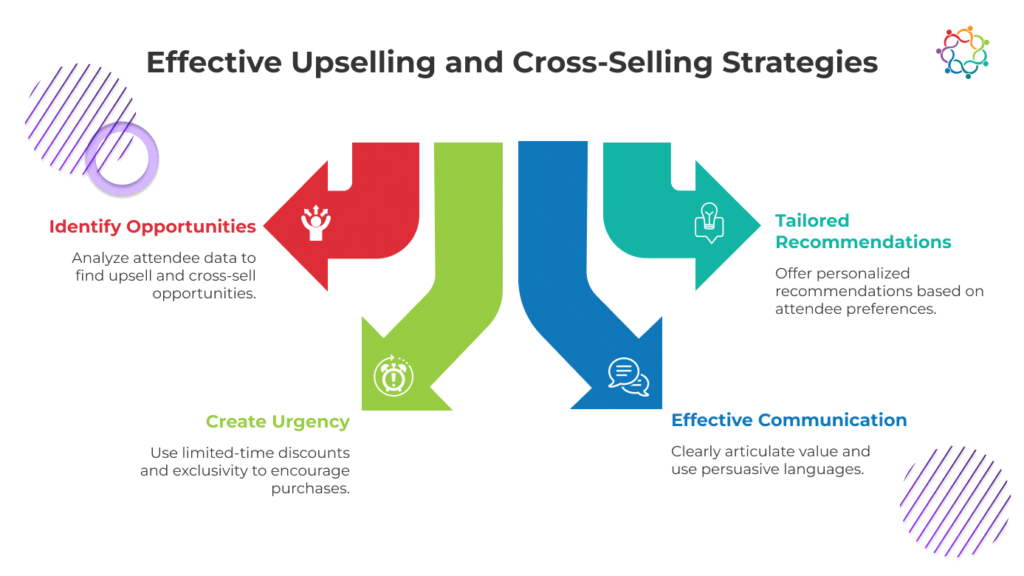
Implementing effective upselling and cross-selling strategies requires a thoughtful approach that engages attendees and enhances their overall experience. Here are key strategies to maximize these opportunities:
Identify Opportunities
To successfully upsell and cross-sell, it’s essential to analyze attendee data to pinpoint potential opportunities. This involves:
Tailored Recommendations
Personalization is critical in both upselling and cross-selling. Here’s how to effectively create tailored recommendations:
Create a Sense of Urgency
Creating urgency can encourage attendees to make quicker purchasing decisions. Here are effective tactics:
Effective Communication
Clear communication about the value of upsells and cross-sells is crucial for convincing attendees. Here are strategies to improve communication:
Training Sales Teams
Your sales teams play a crucial role in executing upselling and cross-selling strategies. Here’s how to equip them for success:
By focusing on these strategies, event planners can not only boost revenue but also foster stronger connections with attendees, ultimately leading to a more satisfying and engaging event experience.
Best Practices for Event-Led Upselling and Cross-Selling
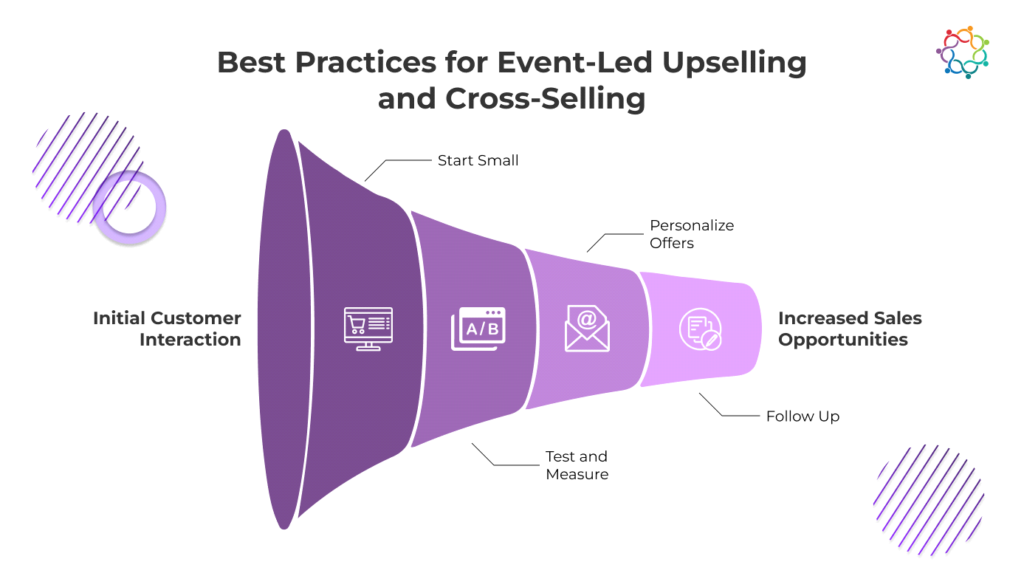
Start Small:
Initiate your upselling and cross-selling efforts with small, manageable offers that are easy for attendees to accept. This approach allows you to build confidence in your strategies while avoiding overwhelming potential customers with too many options. By starting with small upsells, you can gradually introduce attendees to the concept of purchasing additional products or services, which helps to create a comfortable buying environment.
Test and Measure:
Experimentation is key to finding the most effective upselling and cross-selling strategies. Implement various tactics and measure their success to identify what resonates with your audience. This may include different pricing models, promotional techniques, or product bundles. Tracking results through metrics like conversion rates and average transaction value will provide valuable insights that can refine your approach over time.
Personalize Offers:
Tailoring recommendations to individual attendees based on their preferences, demographics, and previous interactions can significantly enhance the effectiveness of your upselling and cross-selling efforts. Utilize data analytics to understand attendee behavior and preferences, allowing you to make personalized suggestions that feel relevant and timely. This personalized touch not only increases the likelihood of acceptance but also enhances the overall attendee experience.
Follow Up:
After the event, reach out to attendees with targeted follow-up communications that highlight additional products or services relevant to their interests. This could include exclusive post-event offers, personalized recommendations based on their engagement during the event, or reminders about products they showed interest in. Effective follow-up can nurture leads and convert interest into sales, further enhancing your revenue potential.
By adopting these best practices, event organizers can create a more seamless experience that not only drives sales but also strengthens attendee relationships, ultimately leading to long-term loyalty and satisfaction.
In the world of sales, relationship-building is essential, as strong connections often lead to greater business opportunities and long-term success. Networking provides sales teams with an invaluable platform to connect directly with prospects, understand their needs, and establish trust—all of which are crucial steps in the sales process. Events, whether they’re industry conferences, trade shows, or intimate gatherings, create a prime environment for meaningful networking by bringing like-minded professionals together in one place.
For sales teams, events are more than just meet-and-greet opportunities; they’re strategic touchpoints to build credibility, nurture leads, and cultivate partnerships that can yield high returns. By honing networking skills and employing effective strategies, sales professionals can turn event interactions into productive relationships, ultimately driving growth for their businesses. This guide highlights proven strategies and techniques for maximizing networking potential at events, from initial preparation to post-event follow-up, empowering sales teams to make the most of every interaction.
Pre-Event Preparation
Effective networking at events starts well before you arrive. A little pre-event preparation goes a long way in making meaningful connections.
Research Attendees
Understanding who will be attending the event can help you target potential prospects and approach them with relevant insights. Reviewing attendee lists, researching companies, and identifying decision-makers who align with your goals gives you a head start. By learning about attendees’ interests, challenges, and potential needs, you can tailor your approach and create more engaging conversations.
Set Networking Goals
Establishing clear goals gives direction to your networking efforts. Whether your objective is to connect with a certain number of prospects, introduce your brand to key players, or set follow-up meetings, defining your aims helps keep your interactions focused. When you know what you want to achieve, you can structure conversations to guide prospects toward those goals while ensuring a valuable experience for both parties.
Practice Your Elevator Pitch
Your elevator pitch is often your first impression, so it’s essential that it’s both clear and compelling. Practice introducing yourself and your company concisely, focusing on your unique selling points and the value you bring to clients. A well-crafted pitch can help you quickly capture attention and spark interest, setting the stage for a deeper conversation. Practicing beforehand allows you to deliver your pitch confidently and adapt it to each individual you meet.
With thorough pre-event preparation, you’ll feel more confident, stay focused, and maximize each interaction, making it easier to build meaningful connections right from the start.
Networking Strategies at the Event
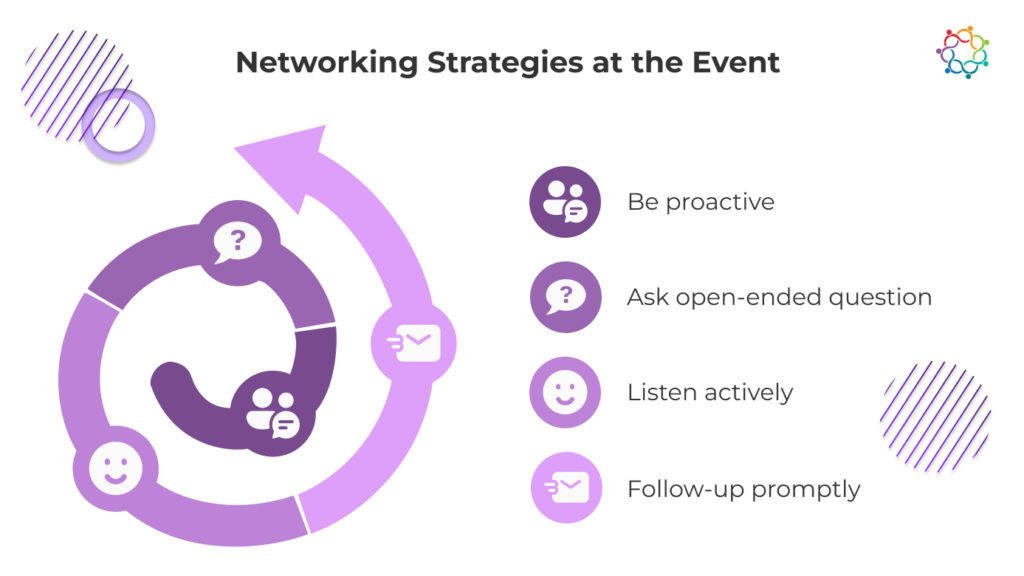
Networking during an event requires a proactive approach and genuine interest in building connections. Here are some effective strategies to help you make the most of each interaction:
Be Proactive
Don’t wait for others to approach you—take the initiative to introduce yourself to new people. Approach attendees with confidence and start conversations by offering a warm greeting and introducing yourself. Making the first move shows confidence, helps break the ice, and positions you as approachable and engaged. Walking around the venue, joining group discussions, or even simply introducing yourself to someone standing alone can lead to valuable connections.
Ask Open-Ended Questions
To foster meaningful conversations, ask open-ended questions that encourage the other person to share more about themselves and their work. Instead of yes-or-no questions, ask about their challenges, current projects, or industry trends they’re interested in. This not only keeps the conversation flowing but also provides insights into their needs and goals, which can help you identify areas where you or your company can add value.
Listen Actively
Active listening is key to building rapport and showing genuine interest in others. Pay attention to what the other person is saying, nodding to acknowledge their points, and responding thoughtfully. By listening more than you speak, you demonstrate respect and interest in their perspective, which makes them feel valued. Remember, successful networking is not about pitching constantly; it’s about fostering genuine connections.
Follow Up Promptly
After an engaging conversation, plan to follow up with a personalized email within 24 hours. Reference specific points from your conversation to show you were paying attention and express your appreciation for their time. A prompt follow-up reinforces your interest in staying connected and can lead to follow-up meetings or future collaborations.
By actively engaging in these networking strategies, you’ll be able to build stronger connections, learn more about your prospects, and ultimately create a positive impact that lasts beyond the event itself.
Effective Networking Techniques
Using targeted techniques during an event can help you make the most of each interaction and leave a lasting impression. Here’s how you can elevate your networking skills:
Join Networking Groups or Activities
Take part in structured networking activities offered by the event, such as speed networking sessions, roundtable discussions, or industry meet-ups. These organized interactions provide a supportive environment to meet people, which can help ease networking anxiety. Being part of these activities often puts you in touch with individuals who share similar goals, making conversations feel more natural and focused.
Leverage Event Apps
Event apps are a powerful tool for connecting with other attendees, scheduling meetings, and sharing contact information. Many event apps, like Samaaro, allow you to view profiles of other attendees, see who’s attending specific sessions, and send direct messages. This way, you can pre-plan introductions and set up one-on-one meetings, helping you create a more purposeful event experience. Additionally, using an app can help you keep track of all your connections, making follow-up easier.
Attend Breakout Sessions and Workshops
Breakout sessions, panels, and workshops are excellent opportunities to engage with peers and industry experts on focused topics. During these sessions, actively participate by asking thoughtful questions and engaging in post-session discussions. This not only broadens your knowledge but also helps you connect with like-minded individuals who share a common interest, which can often lead to more meaningful relationships.
Offer Value
One of the best ways to build credibility and trust is to share valuable insights or expertise. Whether you’re discussing industry challenges, sharing tips, or offering solutions, providing value in your conversations can leave a positive, lasting impression. Look for ways to help others with insights or resources, as this selfless approach can make you memorable and respected. Remember, networking is about building relationships rather than just promoting yourself, and helping others builds goodwill that often comes back in unexpected ways.
By incorporating these techniques, you’ll not only expand your network but also deepen the quality of your professional relationships, creating lasting connections that benefit both your career and personal growth.
Post-Event Follow-Up
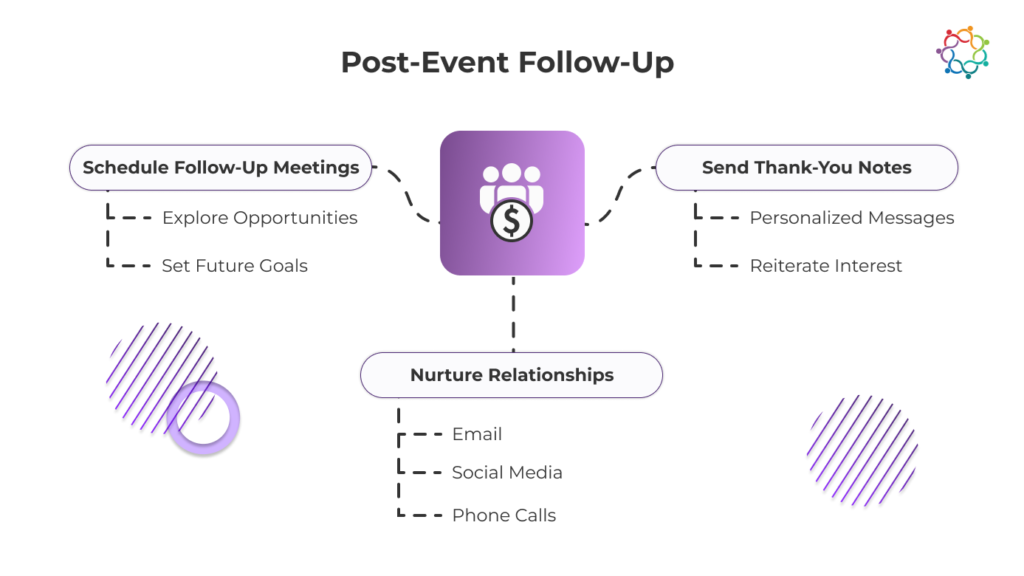
Following up after an event is a critical step to turn networking connections into lasting relationships. After returning from an event, make it a priority to reach out to the people you connected with while the conversations and impressions are still fresh. Here’s how to make your follow-up effective:
Send Personalized Thank-You Notes
Expressing gratitude is a great way to leave a positive, lasting impression. Send a brief thank-you note via email or LinkedIn to acknowledge the interaction and mention a specific detail from your conversation to show that you were genuinely engaged. Personal touches like this demonstrate professionalism and help reinforce the connection.
Schedule Follow-Up Meetings
If you identified specific opportunities or topics of mutual interest during the event, arrange a follow-up meeting to dive deeper. A quick coffee chat or virtual meeting can help solidify the relationship and explore how you might work together. Be clear about the purpose of the meeting, and suggest a few convenient times to make scheduling easier.
Nurture Relationships Over Time
Keeping a network strong requires more than just a one-time follow-up. Regular check-ins, sharing relevant articles, or sending congratulations on achievements help maintain connections in a meaningful way. Using LinkedIn, email, or even a CRM can help you track these touchpoints and keep up with your contacts’ updates and professional progress.
By following up effectively, you’re not only making yourself memorable but also building the foundation for a professional relationship that can lead to long-term opportunities.
Overcoming Networking Challenges
Networking can sometimes be daunting, particularly if you’re shy or new to an industry. Here are strategies to help overcome common networking challenges:
Overcoming Shyness
For introverts or anyone experiencing social anxiety, large networking events can feel overwhelming. Prepare in advance by practicing your elevator pitch and rehearsing a few key talking points. Start conversations with open-ended questions that get others talking about themselves, as this can relieve the pressure of carrying the conversation. Remember, small steps are valuable – even a few quality connections are worthwhile.
Dealing with Rejection
Not every conversation will lead to a strong connection, and sometimes you may encounter people who are disinterested or unavailable. Instead of taking it personally, view rejection as part of the networking process. Focus on those who are genuinely interested in connecting, and keep a positive attitude. Each experience offers a learning opportunity that builds resilience, which will help you confidently approach new connections in the future.
By addressing these challenges directly, you can become more comfortable in networking environments and build confidence, enabling you to make the most of each event and grow your network in a meaningful way.
Conclusion
Building relationships through events is essential for sales teams looking to expand their networks and create growth opportunities. By implementing these networking strategies—both during and after the event—sales professionals can build rapport, establish valuable connections, and ultimately enhance their sales outcomes.
Ready to see how Samaaro can support your networking goals? Book a demo and start your free trial.
Event-based lead generation is a powerful tool, but to make it truly effective, it’s essential to not only execute a great event but also attract the right audience from the start. Targeting the right participants who are likely to convert into customers is key to event success. It involves understanding who your ideal customer is, ensuring your event content resonates with them, and creating messaging that compels them to attend. Without a well-defined target audience, even the best event can fall short in delivering quality leads.
What is Event-Based Lead Generation?
Event-based lead generation refers to the process of using events—whether virtual, hybrid, or in-person—to attract potential customers and convert them into qualified leads. These events provide direct access to prospects, enabling personal interaction and valuable insights that are hard to achieve through other marketing channels. Events help establish brand credibility, showcase products, and nurture relationships in a highly interactive environment.
Benefits of Event-Based Lead Generation
Using events to generate high-quality leads offers several benefits:
Key Strategies for Effective Lead Generation Through Events
The success of event-based lead generation hinges on a combination of understanding your audience, creating a compelling event narrative, and employing effective lead capture and follow-up strategies.
Understanding Your Target Audience
The foundation of effective lead generation starts with a clear understanding of your target audience. To ensure your event resonates with the right people:
Creating a Compelling Event Narrative
To attract the right attendees, it’s crucial to create a narrative that resonates with them and piques their interest even before the event begins. Pre-event communication plays a big role here.
Effective Lead Capture Strategies
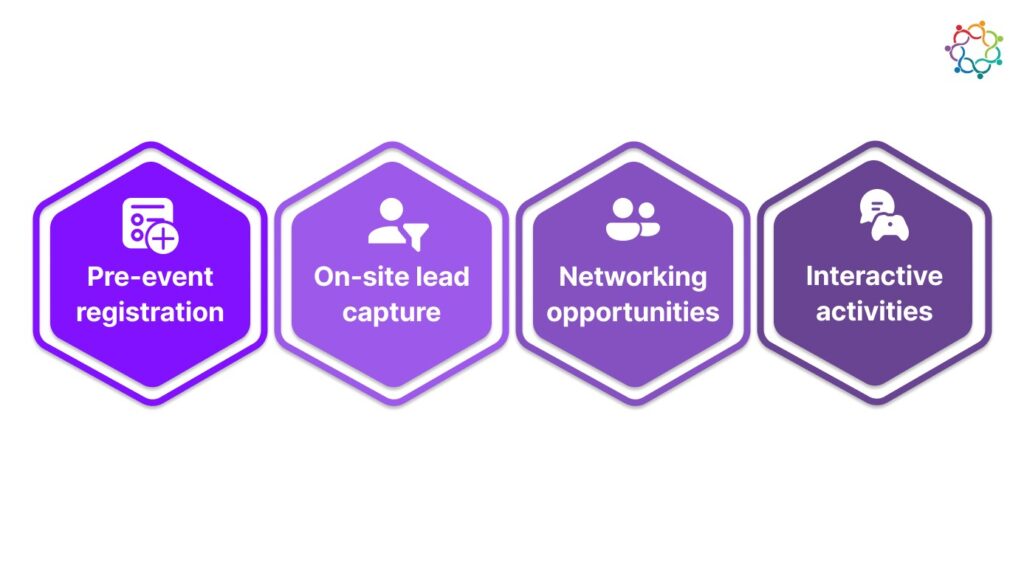
Capturing leads effectively during the event is crucial for long-term success. Here are some strategies to ensure you’re not missing opportunities:
Post-Event Follow-Up
Your event’s success depends heavily on what happens after it ends. Following up in a timely and personalized manner can turn interested attendees into loyal customers.
Measuring Lead Quality and Conversion Rates
After the event, it’s essential to measure the effectiveness of your lead generation efforts. Here’s how you can track success:
Best Practices for Event-Based Lead Generation
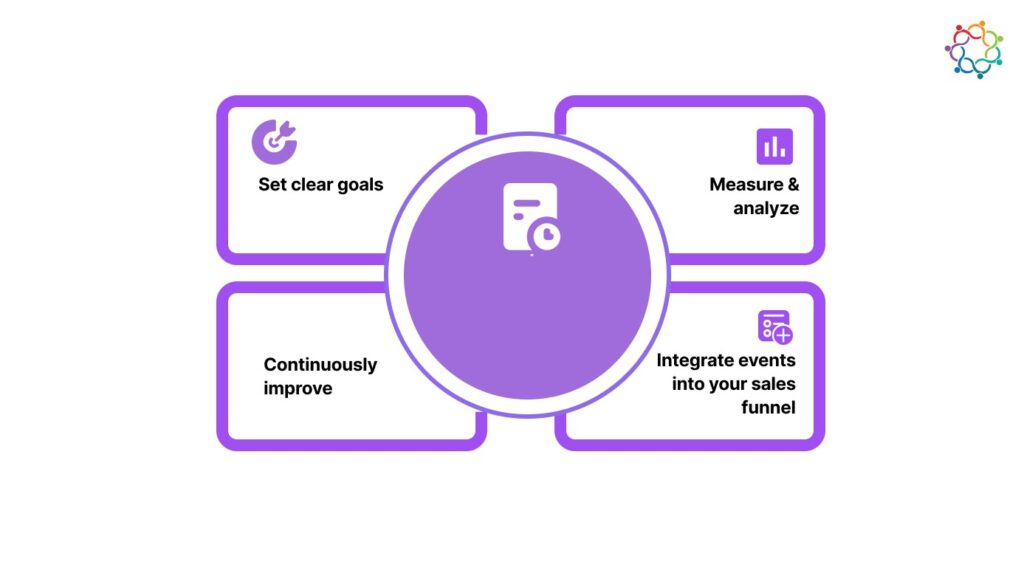
Implementing effective best practices for event-based lead generation can enhance your marketing efforts and drive business growth. Here are key strategies to consider:
1. Set Clear Goals
Establish specific objectives for your event, such as generating a certain number of leads or increasing brand awareness within a target audience. Defining key performance indicators (KPIs) aligned with these goals helps guide your planning and execution. Clear goals ensure that all team members work toward a unified objective, making the event more focused and effective.
2. Measure and Analyze
Tracking essential metrics like registration numbers, engagement rates, and lead conversions is crucial for evaluating your event’s success. Use event management software for real-time data tracking and analysis. After the event, compare actual outcomes against your initial goals to identify trends and areas for improvement. This data-driven approach enables you to refine strategies for future events.
3. Continuously Improve
Post-event evaluations are essential for optimizing future lead generation efforts. Collect feedback from attendees and team members to understand what worked well and what didn’t. Utilize surveys and interviews to gather insights, focusing on common themes. Use this feedback to make informed adjustments to your event planning and execution processes.
4. Integrate Events into Your Sales Funnel
Ensure that the data collected during events is seamlessly integrated into your CRM system. This integration allows for better tracking and management of leads, supporting your overall sales efforts. By aligning events with your sales funnel, you can effectively nurture leads and maximize the impact of your marketing initiatives.
By implementing these best practices, you can transform your events into powerful lead generation tools that drive growth and engagement for your business.
Conclusion
Using events as a strategy for generating qualified leads can offer immense value to businesses, providing direct access to potential customers and fostering deeper relationships. By targeting the right audience, creating a compelling event experience, capturing leads effectively, and following up with personalized communication, you can maximize the success of your event-based lead generation efforts.
Want to see how Samaaro can help you streamline your lead generation process through events? Book a demo and start your free trial today!
Post-event evaluation is more than just a routine task—it’s an essential step in reflecting on both the successes and challenges of an event. Often, in the rush to move on to the next project, this crucial phase can be overlooked. However, it’s where we uncover valuable insights that lead to better decision-making and sharper strategies for future events. Thoroughly assessing the event allows us to improve long-term outcomes and create more impactful attendee experiences.
Every event presents lessons. Successes highlight what worked well and should be replicated, while failures reveal areas that need adjustments. By evaluating both, we learn how to enhance engagement, logistics, and overall event outcomes. It’s not just about asking, “Was the event a success?” but also, “How can we make the next one even better?”
This evaluation phase turns feedback and data into actionable insights. By focusing on key areas like attendee satisfaction, networking opportunities, event logistics, and ROI, we can continuously improve and evolve with each event. Post-event analysis ensures we don’t just repeat past mistakes but instead grow with each experience, delivering more successful events every time.
Key Areas for Evaluation

Attendee Satisfaction:
One of the most important metrics for any event is how satisfied the attendees were. This can be gauged by analyzing surveys, feedback forms, and even informal conversations collected during and after the event. Attendee feedback provides direct insight into their experience, including what they enjoyed, what they found lacking, and what could have enhanced their time at the event.
Look at ratings on areas like the quality of content, speakers, and networking opportunities. Identify areas of excellence—what attendees found most valuable—and note any consistent criticisms. If multiple attendees report issues such as unclear communication or poor logistics, these are critical areas to address for future improvement. Listening to attendee feedback is key to ensuring continuous improvement in your event planning and execution.
Event Goals and Objectives:
Every event is created with specific goals in mind—whether it’s increasing brand awareness, launching a product, or generating leads. During post-event evaluation, it’s important to assess whether these goals were met. Did the event deliver on its intended objectives?
This process involves a clear comparison of what was intended versus what was achieved. For example, if the goal was to drive attendee engagement through interactive sessions, how many attendees actively participated? Did the event generate the intended buzz on social media or press coverage? Understanding where the event excelled and where it fell short in relation to the initial goals provides a clearer sense of how successful it was.
Return on Investment (ROI):
Calculating the return on investment is a key part of any post-event evaluation. While financial ROI is important—measuring revenue generated against the costs—it’s also essential to consider the intangible benefits. Events can create significant value in terms of brand awareness, networking, and relationships, which don’t always show up directly on the balance sheet.
To calculate ROI, start by outlining the event’s costs, including venue, technology, marketing, and staffing. Compare that to revenue from ticket sales, sponsorships, and deals closed as a result of the event. However, don’t stop there. Look at non-monetary gains such as increased customer satisfaction, improved brand reputation, and long-term relationships that could yield future revenue.
Lead Generation and Conversion:
Lead generation is often one of the primary goals of events, especially in B2B settings. It’s important to not only evaluate the number of leads captured but also to look at the quality of those leads. Were the leads gathered well-matched to your target audience?
It’s also crucial to assess how effective the event was in converting leads into potential clients or customers. What was the follow-up process like, and how many leads were converted into actual business? Tracking conversions helps measure the event’s true impact on business development.
Networking and Engagement:
Networking is one of the most valuable aspects of attending an event, and it’s essential to measure how effectively your event facilitated these opportunities. Did attendees engage with each other, the speakers, or exhibitors in a meaningful way? Did your event encourage meaningful conversations and connections?
To evaluate networking success, consider factors like the number of one-on-one meetings scheduled, participation in networking sessions, and attendee feedback regarding their experience. Identify what helped foster productive networking—whether it was the structure of the event, the environment, or specific tools like matchmaking technology. Understanding what drove networking success will help refine future events to promote even more effective engagement.
Event Logistics and Execution:
The operational side of the event is just as important as the content. Were all the logistical details handled smoothly? This includes everything from registration to session scheduling, venue setup, and tech management. Post-event, evaluate how smoothly each component of the event ran. Were there any hiccups with registration? Did sessions start and end on time? Were there any noticeable delays or logistical issues?
By examining the operational execution of the event, you can spot areas for improvement, whether it’s through better communication, more detailed planning, or improved coordination with vendors. Streamlined logistics help ensure that the event runs smoothly and leaves attendees with a positive experience.
Social Media Engagement:
In today’s digital world, social media is an important barometer for the success of an event. Analyzing social media engagement gives you insight into how well your event resonated with the online audience. Were attendees actively sharing their experiences, mentioning your brand, and engaging with your event content online?
Social media analytics can help track mentions, shares, likes, and comments, but it’s also important to look at sentiment analysis. Are people talking positively about the event, or are they sharing criticisms? Analyzing these conversations allows you to spot trends, gauge public opinion, and identify influencers who helped spread the word about your event.
By carefully reviewing these key areas, you can not only celebrate your event’s successes but also gather actionable insights that will help you deliver even more successful events in the future.
Data Collection and Analysis Tools
To effectively conduct a post-event evaluation, having the right data collection and analysis tools is crucial. These tools help you track key performance indicators (KPIs) and offer insights that inform your future event strategies. Below are some of the primary tools used for collecting and analyzing data after an event, and how they contribute to a comprehensive post-event assessment.
Event Management Software:
Event management software, like Samaaro, plays a pivotal role in tracking the overall performance of an event. Such platforms come equipped with features for monitoring attendance, engagement, and lead generation. With Samaaro, you can gain real-time insights into attendee behavior, from registration to check-in and participation in various sessions.
Samaaro’s platform can provide detailed data on which sessions attendees joined, how long they stayed engaged, and what content they interacted with the most. The software allows you to capture leads at various touchpoints throughout the event—whether attendees download a brochure, participate in polls, or schedule one-on-one meetings. This robust data collection ensures you have a holistic view of attendee engagement and behavior, which can directly inform post-event reporting and follow-ups.
Beyond just tracking engagement, Samaaro’s event management software can seamlessly integrate with other tools like CRM systems to streamline lead generation and conversion tracking. Additionally, the platform offers automated reporting features, making it easier to analyze KPIs such as session popularity, traffic flow, and the effectiveness of networking opportunities. This not only simplifies post-event evaluation but also provides actionable insights that help in improving future events.
Survey Tools:
Surveys provide direct attendee feedback, offering insights into their experience. Tools like Google Forms or SurveyMonkey help gather responses on various aspects of the event, such as content quality and overall satisfaction. This feedback identifies what worked well and highlights areas needing improvement, giving you a clear picture of attendee sentiment.
Social Media Analytics:
Social media platforms can reveal how engaged attendees were online. By tracking event mentions, hashtags, likes, and shares using tools like Hootsuite or native analytics, you can ga
uge the event’s digital impact and reach. Social media feedback often highlights popular elements and uncovers areas of improvement based on attendee reactions.
CRM Software:
CRM systems like Salesforce or HubSpot track leads generated during the event. Integrated with event management platforms, they allow you to follow up on leads and assess conversion rates. This helps you measure the event’s impact on sales and lead nurturing efforts, ensuring long-term ROI from your event.
These tools work in synergy to provide a comprehensive evaluation of your event’s performance. Event management software like Samaaro tracks attendee behavior in real-time, while survey tools offer direct attendee feedback. Social media analytics measure your event’s digital impact, and CRM software ensures that lead generation and conversions are accurately tracked. Together, these tools enable a data-driven approach to post-event evaluation that can significantly enhance future event planning and execution.
Best Practices for Post-Event Evaluation

Set Clear Objectives
Start by defining what you want to learn from the event. Whether it’s measuring attendee satisfaction, evaluating lead generation, or assessing networking success, having clear goals upfront ensures you know what to focus on during the evaluation process. This clarity also helps in gathering the right data to meet those specific objectives.
Collect Data from Multiple Sources
To get a well-rounded view of your event, gather data from various sources. Surveys are great for direct feedback from attendees, while social media platforms can reveal public sentiment and engagement. Event management tools, like Samaaro, can track metrics such as attendance, session participation, and lead generation, giving you a more complete picture of the event’s performance.
Analyze Data in Detail
Go beyond surface-level metrics. Instead of just looking at the number of attendees, explore how engaged they were—did they stay for the whole event? Were they active in sessions? By diving deeper into the data, you can uncover hidden insights that might not be immediately obvious, allowing for more accurate assessments.
Identify Areas for Improvement
Use your data to identify both strengths and weaknesses. Recognizing what went well helps in replicating success, while pinpointing areas for improvement allows you to address challenges in future events. Look for patterns in feedback and engagement to understand where changes could make the most impact.
Share Insights with the Team
Once you’ve gathered and analyzed the data, share the findings with your event team and stakeholders. Clear communication of successes and areas for improvement ensures that everyone is aligned and can contribute to making future events even better. Collaboration is key to turning insights into actionable improvements.
Conclusion
Post-event evaluation is an essential part of the event planning process, helping you learn from both successes and challenges. By setting clear objectives, gathering data from multiple sources, and analyzing it in detail, you can uncover valuable insights that drive continuous improvement for future events. Whether it’s enhancing attendee satisfaction, optimizing logistics, or improving lead generation, a thorough evaluation ensures that every event gets better than the last.
Ready to take your event strategy to the next level? Book a demo with Samaaro and start your free trial to see how our platform can help you streamline your event management and gather the data you need to deliver exceptional experiences.
Let’s face it—when it comes to smaller, curated events with up to 50 people, an event app might feel a little over the top. But once you’re hosting something larger, say with 150-200+ participants, an event app becomes a modern essential. It’s not just about registration or networking anymore; it’s about creating a seamless, engaging experience for both attendees and organizers.
Event apps have moved beyond basic functions, offering a range of features that elevate the attendee experience while making event management more efficient. If you’re running larger events, you’ll find that an event app isn’t just a tool; it’s a game-changer.
Beyond Registration and Networking: Key Features of Event Apps
Personalized Attendee Experiences
With an event app, it’s not a one-size-fits-all experience anymore. Imagine being able to curate tailored agendas for each attendee based on their preferences, session attendance, or even who they want to network with. The app can send personalized notifications and updates, making sure everyone stays on track with reminders they actually care about.
You can even create detailed attendee itineraries with all the specifics—from session schedules to hotel room numbers and even flight details. This level of personalization adds a touch of luxury to the whole event experience.
Interactive Content
Event apps let you go beyond passive content. You can engage attendees with polls, quizzes, and interactive sessions that not only keep them involved but also help you gather valuable insights. Throw in some gamification—leaderboards, badges, or even prizes—and suddenly you’ve turned a conference into an exciting, interactive event. It’s a fun way to boost engagement and make sure people are actively participating.
Networking and Matchmaking
We all know networking is a key reason people attend events. With an event app, networking moves from awkward icebreakers to more structured, AI-powered matchmaking. The app can recommend connections based on shared interests, backgrounds, or industries, making networking feel more natural and meaningful. Plus, features like one-on-one meeting scheduling or group discussions can help people connect easily, whether they’re in person or virtual.
Meeting Planners and Lead Generation
Here’s where event apps really shine for organizers. The app doesn’t just handle registration—it tracks everything. When attendees participate in certain sessions, download brochures, or watch product videos, the app captures all of that digital activity. This generates a valuable digital footprint of interest and intent, allowing you to understand what leads are actually interested in.
Better yet, many event apps can integrate with your CRM, making it super easy to follow up on leads and continue the conversation long after the event ends.
Payment Processing
Need to sell tickets, offer merchandise, or collect donations during the event? No problem. Event apps can come with built-in payment gateways, simplifying the whole process for both organizers and attendees. No more juggling third-party systems or worrying about handling payments manually.
Analytics and Reporting
We all want to know if our event was a success, right? Event apps provide real-time analytics, letting you track key metrics like attendance rates, session engagement, and even social buzz. At the end of the day, you can generate detailed reports that help you analyze what worked and what didn’t, so the next event can be even better.

How Event Apps Can Enhance the Event Experience
Improved Attendee Satisfaction: Personalization, interactive features, and reduced waiting times make attendees happier.
Increased Engagement: Gamification, interactive content, and networking tools keep people actively involved throughout the event.
Enhanced Lead Generation: With all the digital tracking, you’ll generate better leads and have data to follow up effectively.
Cost Savings: Going digital cuts down on printing costs, streamlines processes, and gives you insights to make smarter budget decisions in the future.
Choosing the Right Event App: Key Considerations
When selecting an event app, keep a few things in mind:
Features and Functionality: Does the app offer the tools you need to hit your event goals?
Integration Capabilities: Make sure it works with your existing systems, like your CRM or marketing tools.
User Experience: A confusing or clunky app is a big turn-off for attendees.
Scalability: Can it handle your event as it grows?
Cost: Pricing matters, but consider the value you’re getting from the app’s features.
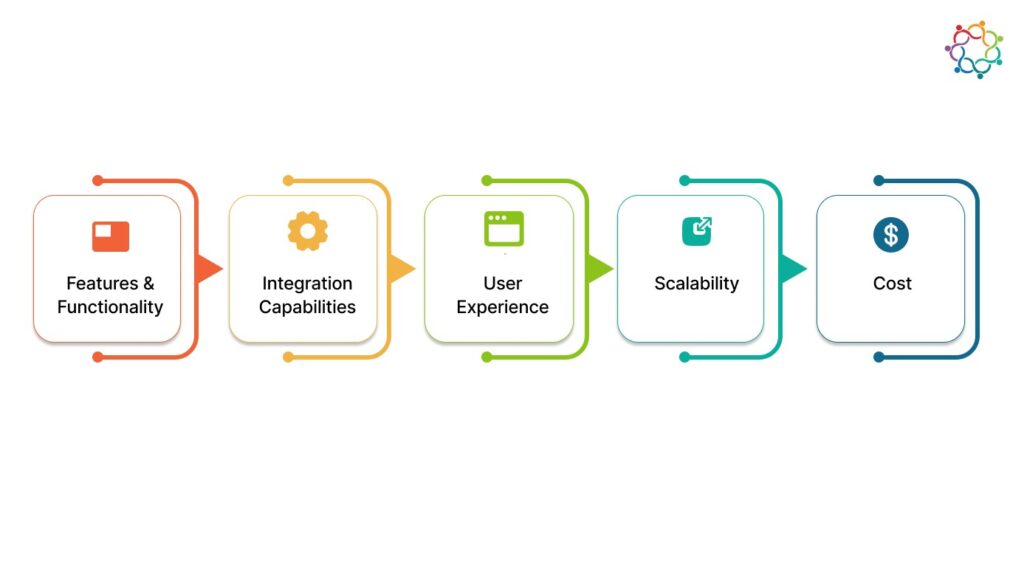
Conclusion
Event apps go way beyond registration and networking—they enhance every aspect of an event, from personalizing the attendee experience to driving better lead generation and engagement. With so many benefits, it’s clear that an event app is a must-have for larger events.
Looking to elevate your next event? Samaaro’s event app does all of this and more. Book a demo today and start your free trial to see how it can transform your event experience!
Let’s be real—just hosting an event and hoping it goes well isn’t enough anymore. If we’re not paying attention to the data, we’re flying blind. These days, it’s all about knowing what worked and what didn’t. And without data, well, we’re just guessing, right?
In this blog, we’re going to dive into what data-driven event marketing really means, why it’s so important, and the key things we should be measuring to make sure our events are actually hitting the mark. We’ll keep it simple and to the point—because we all know, no one has time for over-complicated theories!
What is Data-Driven Event Marketing?
So, data-driven event marketing is about using real numbers, real insights to make decisions, instead of just winging it. It’s about learning from each event, seeing where we nailed it and where we might have missed the mark. Think of it like this: data gives us the story behind the event, the context, and the “why” behind things.
For example, if a session had low attendance, it’s easy to assume people weren’t interested, but maybe it clashed with lunch or something else. Data helps us see the nuance and make sense of the messiness. Events can be chaotic, and without digging into those numbers, we’re just guessing. And who wants that?
Why Data Matters in Event Marketing?
Honestly, without data, we’re just shooting in the dark. It’s not just about knowing how many people showed up but about figuring out why they came, what they cared about, and what we could do better next time. Plus, how do we justify the event budget if we don’t know if it was worth it?
Here’s why we need to care about data:
ROI Tracking: The bottom line—did we make money, or just spend a lot? Data gives us the hard facts.
Engagement: Were people genuinely interested, or were they just there for the freebies? Tracking engagement shows us how much people are actually participating.
Continuous Improvement: Every event teaches us something. With data, we’re learning from each one and making the next one better.
Proving Value: Whether it’s for the boss or the client, hard numbers show the value of our event in a way we can’t always explain.
Key Metrics to Measure
We could drown in data if we wanted to, but let’s stick with the key metrics that really matter.
1. Attendance and Engagement
2. Lead Generation and Conversion
3. Return on Investment (ROI)
4. Social Media Engagement
5. Net Promoter Score (NPS)
6. Customer Feedback
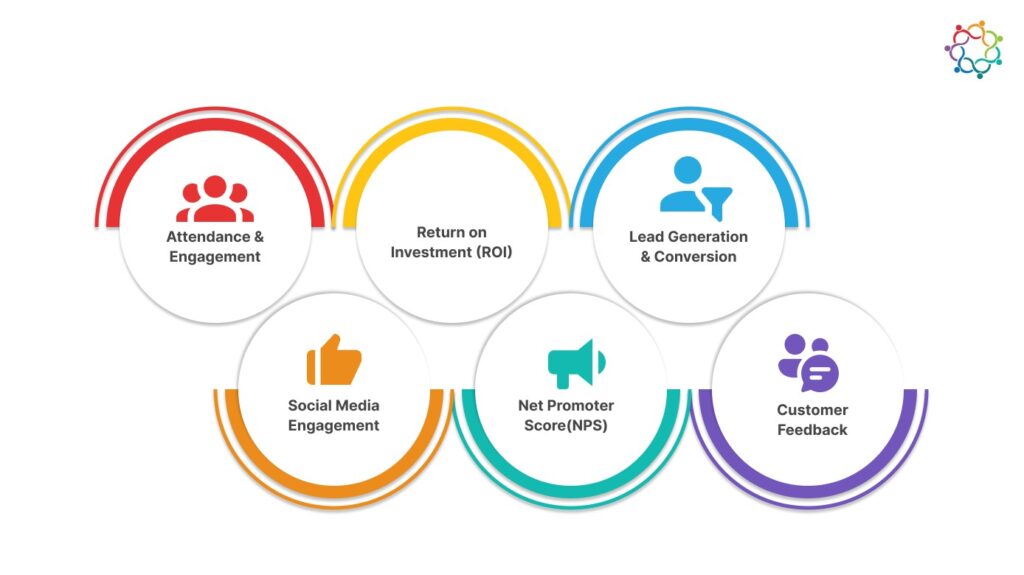
Data Collection and Analysis Tools
Collecting all this data manually? No thanks. We need the right tools to do it efficiently. Here’s what we recommend:
Event Management Software: Platforms like Samaaro help us track attendance, engagement, and leads all in one place.
Analytics Tools: Google Analytics, social media platforms, survey tools—they help us keep tabs on everything from web traffic to social buzz.
CRM Software: CRM’s help manage leads, track conversions, and analyze sales data, making it easier to quantify the long-term value of event-generated leads.
Best Practices for Data-Driven Event Marketing
To make the most of our data, there are a few best practices we should follow:
Set Clear Objectives: What are we trying to achieve? Are we focusing on leads, sales, or awareness? Let’s be clear about our goals before diving in.
Collect the Right Data: We can’t track everything, so let’s stick to what matters most for our objectives.
Use Data to Make Decisions: What’s the point of all this data if we’re not actually using it? Let’s make sure it’s guiding our future event strategies.
Continuous Improvement: Every event gives us more to learn. Let’s use that data to make the next event even better.
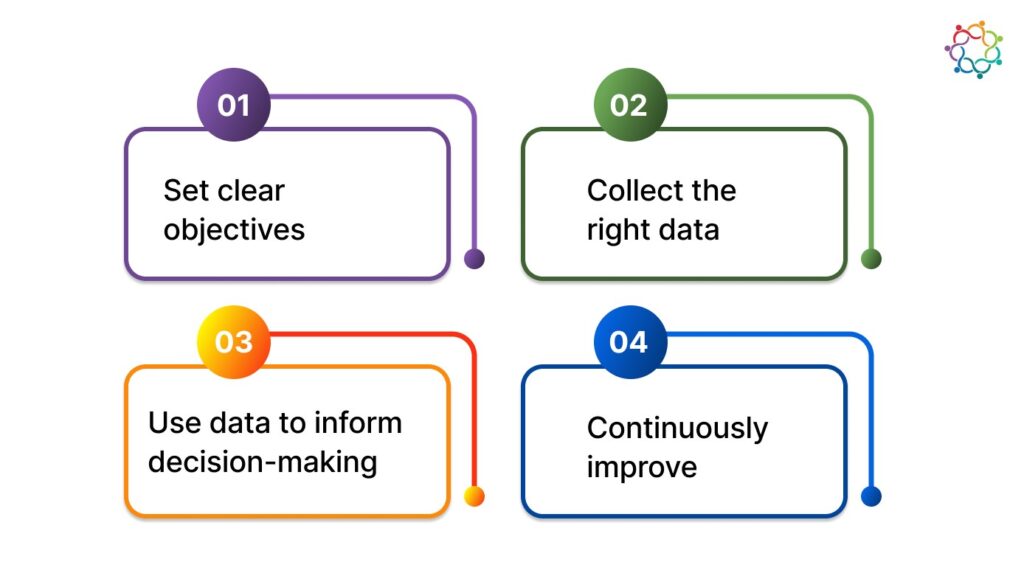
Conclusion
At the end of the day, data-driven event marketing is how we make sure we’re not just running events but running successful ones. By focusing on key metrics—engagement, leads, ROI, and social buzz—we can get a real sense of what worked and what needs tweaking. And the best part? Each event makes us a little smarter for the next one.
Ready to take your events to the next level? Book a demo with Samaaro and start your free trial today to see how our platform can help you track and optimize the data that matters most!
In today’s hyper-digital world, traditional PR methods—like press releases and paid ads—are quickly losing their edge. Consumers are becoming immune to the constant barrage of information and increasingly skeptical of over-polished brand messages. They crave something real, something they can experience rather than just see or hear. This shift is driving brands to rethink their PR strategies, and one solution is standing out from the rest: event marketing.
2024 is the year events step into the spotlight as the new PR powerhouse. No longer are events just a means of gathering people together—they’ve evolved into immersive, brand-defining experiences that create genuine connections and leave a lasting impression. From product launches to large-scale brand activations, events offer a unique opportunity to break through the noise and engage audiences in a meaningful, memorable way.
Consumers today aren’t looking for just another product; they want to feel the brand, interact with it, and walk away with a story to tell. This is where events shine. They provide the perfect platform for brands to craft these experiences, driving brand loyalty, sparking organic buzz, and transforming attendees into brand advocates. It’s not just about what you say anymore; it’s about how you make people feel, and nothing does that better than a well-executed event.
But why are events so effective in this new PR landscape? Let’s dive into why event marketing is poised to be the most powerful tool in your PR arsenal this year.
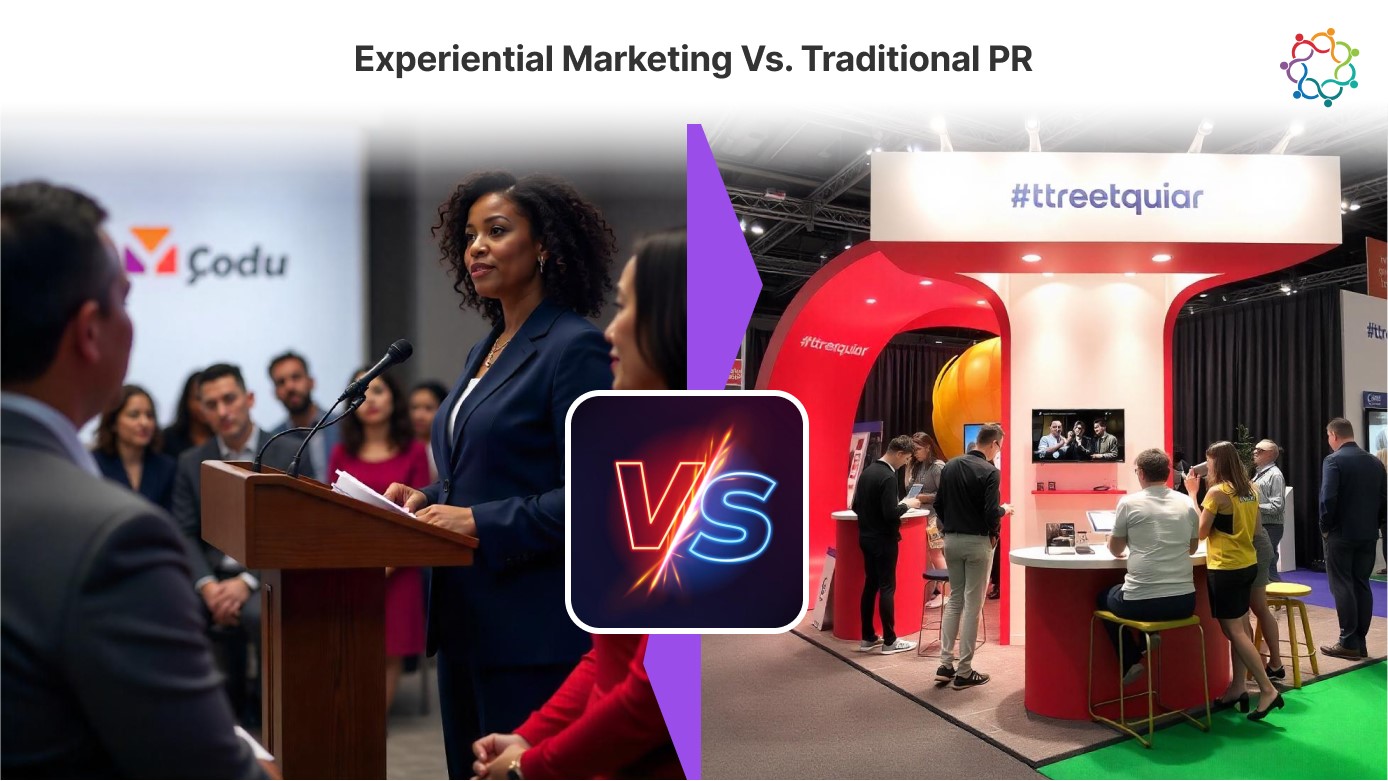
Why Events are the Future of PR
Experiences Over Ads
In a world where people are bombarded with thousands of ads each day—whether it’s on social media, billboards, or TV—traditional advertising is losing its impact. Consumers have developed a kind of immunity, scrolling past ads without a second thought. What they’re looking for instead are authentic experiences. Events offer a unique opportunity to provide this. Instead of just promoting a product or service, events allow consumers to interact with a brand in a hands-on, immersive way. Attendees can engage with your brand’s story, feel the energy, and be a part of something memorable. This emotional connection is far more powerful than any traditional ad can achieve, leading to stronger brand loyalty and deeper customer relationships.
Two-Way Communication:
One of the biggest advantages of events is the opportunity for direct, real-time interaction. Traditional PR methods like press releases or advertisements are one-sided; they tell the audience what the brand wants to say. Events, on the other hand, open the door for two-way communication. They allow brands to engage with their audience, listen to feedback, and respond to questions in real-time. This creates a sense of personal connection that can’t be achieved through a television spot or a print ad. Consumers are far more likely to trust and advocate for brands they’ve had personal, positive interactions with—especially when they feel heard and valued.
A Content Goldmine:
Events aren’t just one-time experiences—they are also a treasure trove of content that can fuel your PR and marketing efforts for months to come. Think about the number of photos, videos, live streams, interviews, and social media posts an event can generate. Attendees naturally share their experiences online, creating organic, user-generated content that carries more authenticity and credibility than traditional branded content. On top of that, you can record sessions, capture testimonials, and create highlight reels that can be repurposed across your marketing channels. The sheer amount of content generated from a single event can provide PR material that keeps your brand top of mind long after the event itself has ended.
Wider Reach and Influence:
Events used to be seen as limited in scope to those who could physically attend. However, in today’s digital-first world, events have the potential to reach far beyond the venue. With live streaming, virtual platforms, and social media, events can now engage audiences globally. This means that a local event can quickly gain national or even international attention. The networking opportunities at these events aren’t limited to face-to-face interactions anymore either. Attendees can connect digitally, forming valuable business relationships and partnerships that extend the influence of the event well beyond its immediate surroundings. Additionally, media coverage, influencer participation, and social media buzz all work together to amplify an event’s reach, making it a powerful tool for increasing brand visibility and awareness.
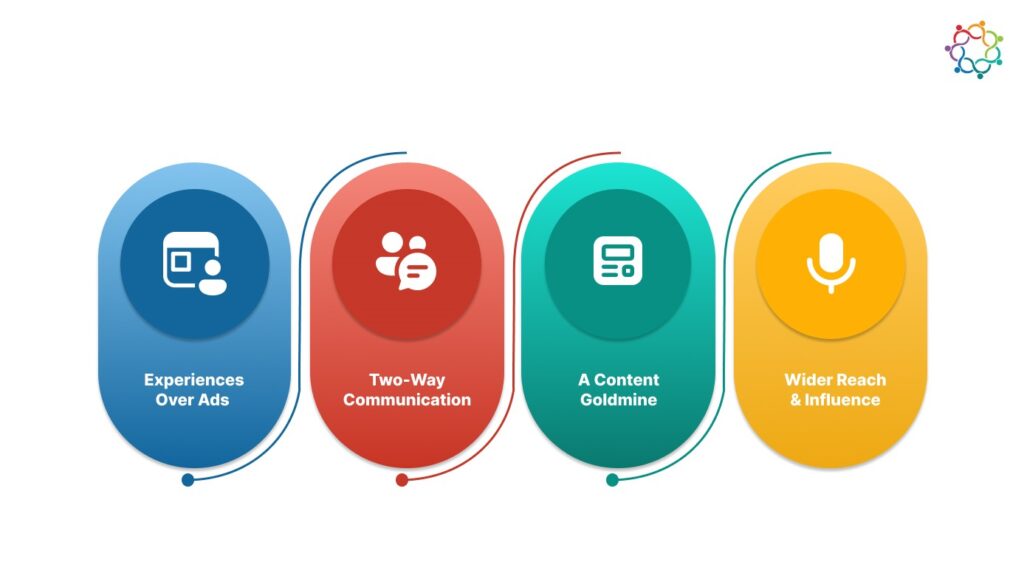
Unlocking New PR Dimensions with Event Marketing
Event marketing has become a pivotal tool for brands looking to reshape their public relations strategies. Beyond just hosting gatherings, events have the potential to open entirely new dimensions for brand growth, visibility, and engagement. Here’s how event marketing can redefine your PR efforts:
Increased Brand Visibility:
A well-executed event doesn’t just engage the attendees on the ground—it can skyrocket your brand’s visibility across multiple channels. Media outlets, influencers, and even casual attendees create organic buzz, which is far more authentic and persuasive than traditional marketing efforts. Live-streaming, social media posts, and event highlights spread your brand’s message far beyond the event itself.
Streamlined Messaging:
With events, your brand has the opportunity to craft a unified, immersive narrative. Every detail—from the decor and the agenda to the speakers and activities—can be aligned to reinforce your core brand message. Instead of relying on fragmented ads or social posts, events provide a cohesive platform where attendees can experience your brand firsthand. And with event technology, you can automate and personalize aspects of your event, ensuring that your message resonates with every attendee. From personalized agendas to customized branding across digital check-in systems and interactive dashboards, event technology ensures that every interaction is on-brand and impactful. Platforms like Samaaro can help you deliver these communications across channels like emails, WhatsApp & social media right where your audience is.
Building Investor Relations:
Events aren’t just for customers—they are crucial for showcasing your brand’s growth and innovation to potential investors. Hosting an event allows investors to see your business in action. Whether it’s a product launch or a networking event, it demonstrates real-time engagement, product traction, and the excitement around your brand. Plus, with robust analytics tools, you can showcase data on attendance, engagement levels, and customer feedback, offering investors clear insights into your brand’s success and market potential. The platform’s ability to capture and present real-time analytics can serve as a powerful tool to validate your market position and impress investors.
Audience Segmentation and Targeting:
One of the often-overlooked advantages of event marketing is the ability to precisely segment and target your audience. Events provide a unique opportunity to interact with different audience segments, whether they’re customers, media, or industry leaders, in a more tailored manner. With attendee management tools, you can track engagement data and customize experiences for different groups. This enables you to deliver personalized messages, resulting in more effective PR outreach. Whether it’s through targeted follow-ups post-event or personalized experiences during the event itself, segmentation ensures that your message is hitting the right audience at the right time.
Amplified Social Proof and Credibility:
Events provide a rich source of social proof, from live testimonials to user-generated content (UGC). Attendees naturally share their experiences on social media, tagging your brand and extending your reach organically. These authentic posts from real people build credibility far more effectively than traditional ads or press releases. By using integrated event platforms, brands can collect and amplify this user-generated content, turning attendees into brand advocates. Post-event, you can repurpose attendee-generated content, such as photos, videos, and social media posts, across various marketing channels, creating a continuous stream of authentic PR material that extends the life of the event.
Strengthening Community Engagement:
Events offer a rare opportunity to build deeper relationships within your community—whether it’s customers, partners, or industry professionals. They create an environment for networking, collaboration, and idea-sharing that strengthens ties and enhances brand loyalty. Digital tools help streamline these interactions with features like virtual networking lounges and live Q&A sessions, making it easier for attendees to connect with each other and your brand. Facilitating these connections adds tremendous value and helps your brand become a hub for community engagement, which in turn strengthens your public image.
Driving Media Attention:
A well-organized, unique event is a magnet for media attention. Whether it’s industry reporters, local news outlets, or niche bloggers, media coverage can significantly amplify the PR impact of your event. The key is to ensure your event is newsworthy—whether by showcasing an innovative product, hosting a high-profile speaker, or creating a buzz-worthy experience. Media attendees can engage directly through event-specific press portals or exclusive interviews, making it easier to attract positive coverage.
Measuring PR Success:
The success of any PR effort lies in measurable outcomes. In the past, it was challenging to quantify the PR impact of an event. Today, however, event technology offers in-depth data that measures everything from social media reach to attendee engagement. Brands can now access detailed insights into how the event contributed to PR goals—such as increased media mentions, social engagement, or lead generation. By providing hard data on event performance, this allows for more refined and strategic PR efforts in the future.
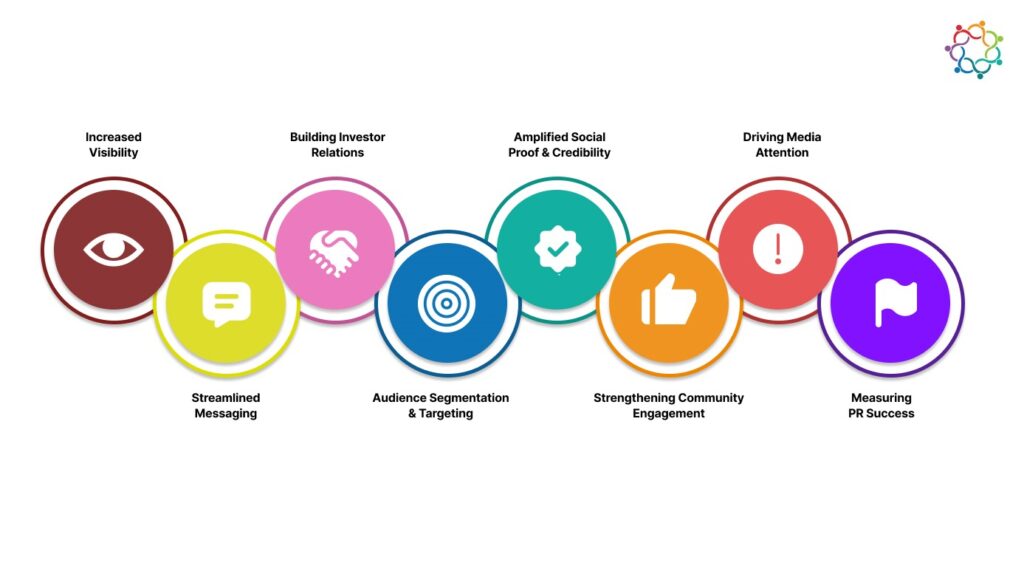
Examples of Events Redefining Marketing Success
Corporate and B2B companies are leveraging events in innovative ways that are reshaping their marketing strategies.
For instance, Microsoft hosts its annual Ignite conference, bringing together thousands of IT professionals and developers. This event not only showcases new products but also cultivates a community of users who engage with the brand on multiple levels, generating substantial media coverage and ongoing conversations.
Another example is Salesforce, whose Dreamforce event attracts attendees from all over the globe. The conference features keynotes from industry leaders, breakout sessions, and networking opportunities, all designed to enhance the brand’s visibility and establish it as a thought leader in the tech industry. By creating immersive experiences, these corporate events transform traditional marketing tactics into engaging and memorable interactions.
The Role of Event Planners in PR-Driven Events
Event planners play a crucial role in the success of PR-driven events. Acting as the backbone of these experiences, they bring invaluable expertise to ensure that each event aligns with a brand’s objectives while maximizing audience engagement and visibility. From conceptualizing a theme to managing logistics, vendor partnerships, and post-event evaluations, planners meticulously handle every detail, ensuring flawless execution. Beyond just the event day, they also track key metrics, offering insights that inform future PR and marketing strategies.
Enhancing Event Success with Technology Platforms
While event planners focus on the creative and logistical aspects, technology platforms like Samaaro help optimize the event’s execution and impact. By streamlining processes such as attendee management, engagement tracking, and post-event analytics, these platforms empower brands to measure success in real-time and adjust strategies accordingly. Leveraging data-driven insights, companies can enhance their PR efforts and drive continuous improvement in their overall event marketing approach.
Creating Buzz: Pre-, During, and Post-Event
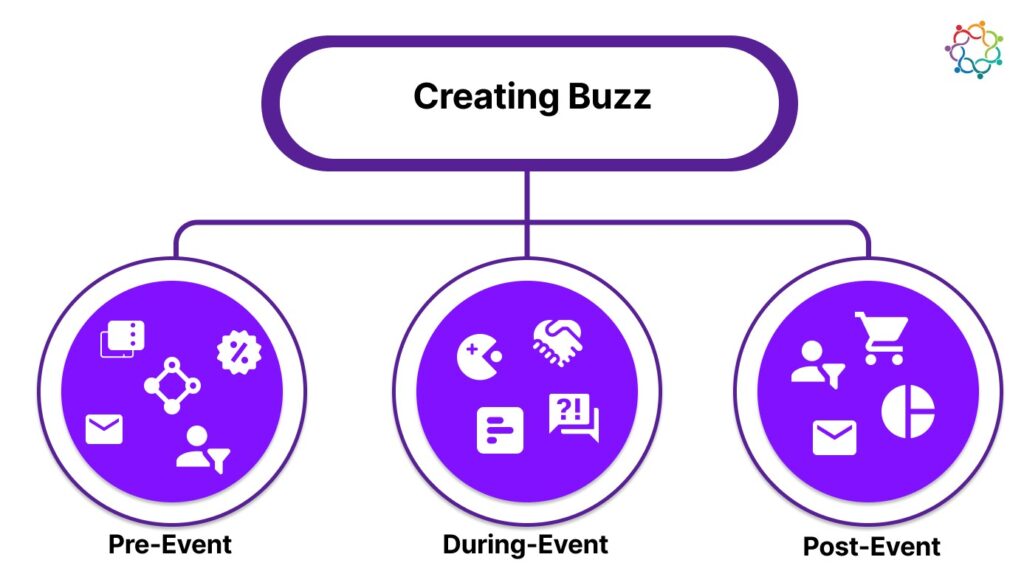
Building anticipation for an event is crucial for driving attendance and engagement. Here’s how to create an effective buzz throughout the event lifecycle:
Pre-Event:
During the Event:
Post-Event:
Influencers: Your PR Multiplier
In the realm of event marketing, influencers can significantly enhance your brand’s visibility and credibility. Here’s how to effectively leverage their impact:
Identify the Right Influencers: Select those who align with your brand values and target audience, ensuring authenticity in their promotion.
Collaborative Opportunities: Offer influencers unique benefits, such as exclusive access or tailored experiences, creating a mutually beneficial relationship.
Pre-Event Buzz: Encourage influencers to generate excitement by sharing sneak peeks, registration links, and personal stories leading up to the event.
Engagement During the Event: Plan exclusive activities for influencers, such as interviews or behind-the-scenes tours, to deepen their connection to your brand.
Post-Event Sharing: Ask influencers to share their experiences after the event, amplifying the message and sustaining audience interest.
Conclusion: Embrace the Event Marketing Powerhouse
In today’s competitive landscape, embracing the power of event marketing can transform your PR efforts, creating authentic connections and lasting impressions. By leveraging strategic event planning, innovative marketing techniques, and influencer partnerships, brands can engage their audiences like never before.
To explore how you can harness these strategies effectively, consider trying out Samaaro. Our platform offers a seamless solution for event management, enabling you to create memorable experiences while measuring their impact.
Request a demo or start your free trial today to see how we can help elevate your event marketing strategy and redefine your brand’s PR success!
Did you know that events with a well-defined marketing strategy see a 30% increase in attendance and a 20% boost in lead generation? Strategic event marketing isn’t just about creating a buzz; it’s about achieving measurable results. This comprehensive checklist serves as your roadmap, guiding you through every stage of the event marketing process and ensuring your event delivers on your goals.
Think of this checklist as your secret weapon against event marketing chaos. Here’s how it empowers you:
1. Pre-Event Marketing: Laying the Foundation (6 Months Before)
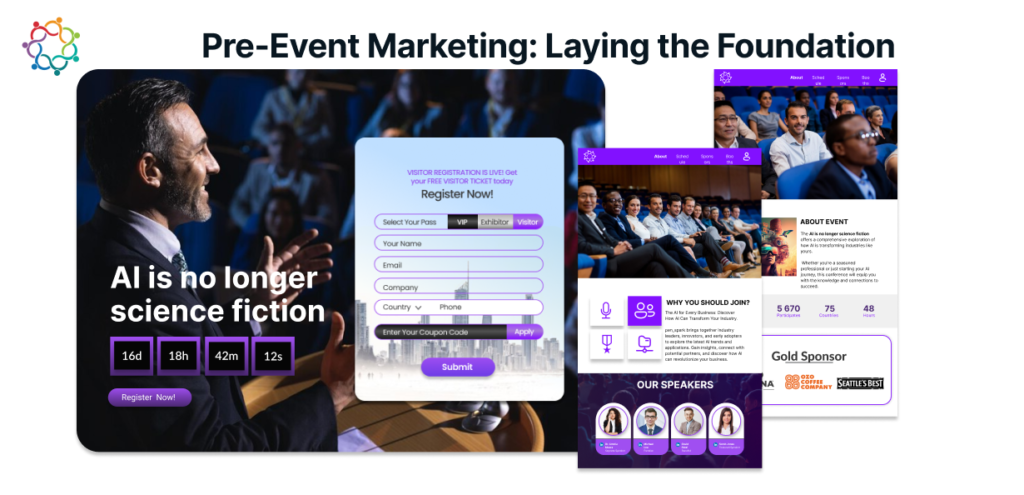
Excitement for your event is building, but before you hit the promotional gas pedal, it’s crucial to lay a strong foundation. The next six months are dedicated to crafting a compelling narrative, identifying your ideal audience, and selecting the most effective channels to reach them. This pre-event marketing phase is where you plant the seeds for a successful and well-attended event:
Define your event’s purpose (e.g., brand awareness, lead generation) and create a buyer persona to understand your target audience (age, interests, pain points).
Develop a consistent brand image and messaging that resonates with your target audience and carries through all the marketing materials.
Identify the most effective channels to reach your audience. Consider social media, email marketing, paid advertising, or industry publications based on your target demographic.
Create a user-friendly website with clear information about the event, speakers, agenda, and a seamless registration process. Simultaneously, design targeted landing pages to capture leads and drive conversions.
Plan and create valuable content (blog posts, videos, infographics) that educates your audience, builds anticipation, and positions you as an industry thought leader.
Secure speakers who align with your event’s theme and potential brand partners who can enhance your offering and expand your reach.
2. Pre-Event Marketing: Building Momentum (3 Months Before)
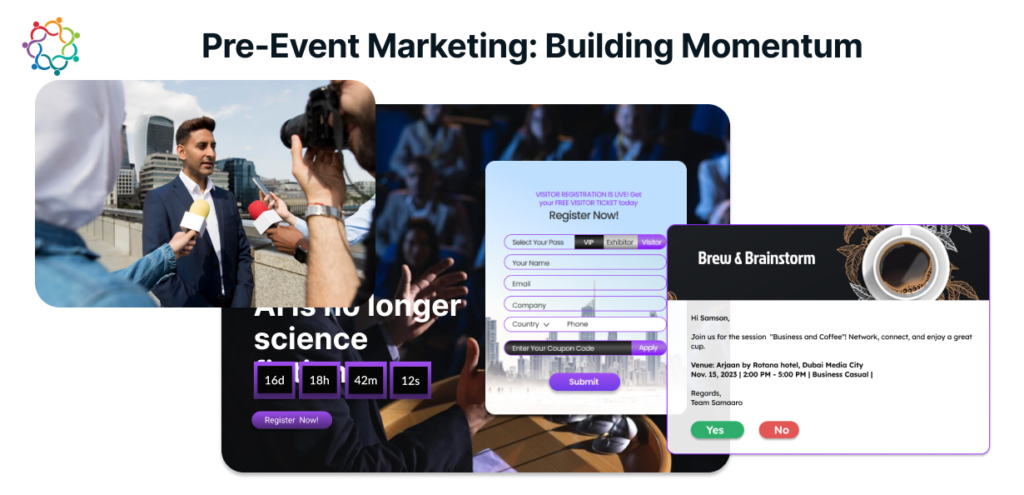
The groundwork is laid, and now it’s time to build excitement. With three months to go until your event, it’s all about generating buzz and amplifying your message. This pre-event marketing phase focuses on launching social media campaigns and email outreach to drive registrations and ensure your event lives up to its potential:
Launch your social media campaign with engaging content, including captivating visuals, event teasers, and targeted advertising to reach a wider audience.
Develop segmented email marketing campaigns for different audience segments. Then, send informative emails about the event to past attendees and nurture leads with valuable content.
Craft strategic press releases and media pitches to attract media coverage and generate buzz about your event.
Design a user-friendly registration process on your event website, ensuring a smooth and efficient experience for the attendees.
Develop digital and print marketing materials (email banners, social media graphics, flyers) that align with your brand identity and effectively communicate the event’s value.
3. Pre-Event Marketing: The Final Push (1 Month Before)

With just one month left until your event, it’s time to shift gears and focus on maximizing attendance and ensuring a flawless experience. Here’s how to make the final push in your pre-event marketing strategy:
This is the time for interactive content that sparks conversations. Run contests and polls to generate excitement, and host live Q&A sessions featuring speakers to give the attendees a taste of what’s to come. Besides, use relevant hashtags and visually appealing content to keep your event at the forefront of your audience’s mind.
2. Targeted Email Reminders:
Don’t let the registered attendees forget about the big day. Send personalized email reminders that reiterate the event details, logistics, and schedule. This is also a great opportunity to showcase speaker bios or highlight any last-minute updates or changes.
3. Influencer Marketing Leverage:
Partner with industry influencers to amplify your reach and attract a wider audience. These established figures have a built-in following who trust their recommendations. Therefore, collaborate with influencers who align with your event theme, and leverage their social media platforms or blog to promote your event to their engaged followers.
4. Finalizing Logistics:
While the spotlight shines on the event itself, true magic happens behind the scenes. This final month is crucial for finalizing all the logistical details. Confirm the venue arrangements, catering services, and audio/visual equipment requirements. Also double-check schedules, speaker needs, and any necessary permits. Because a meticulous approach ensures your event runs smoothly and leaves a positive impression on the attendees.
4. During-Event Marketing: Keeping the Flame Alive
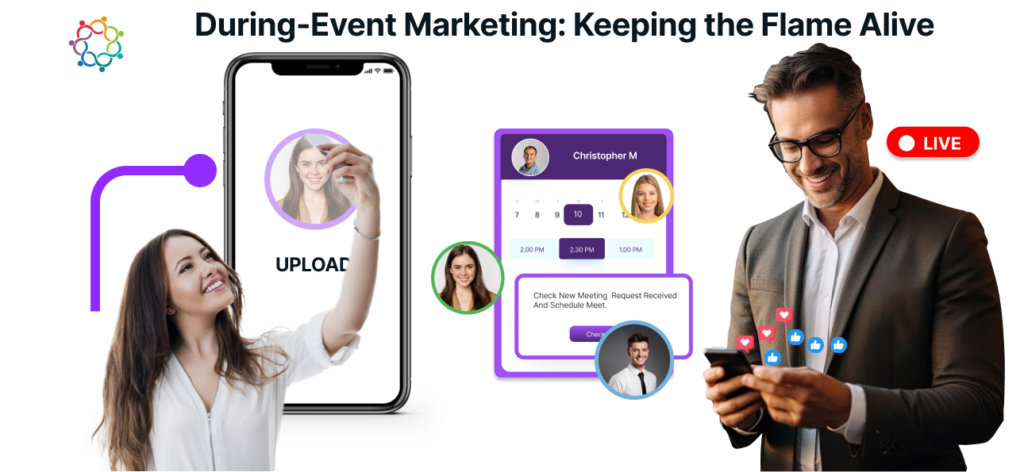
The months of planning will culminate in the live event experience. But your job isn’t done yet. During-event marketing is all about maintaining momentum, encouraging attendee engagement, and capturing valuable feedback. Let’s explore strategies to keep the flame alive and ensure your event leaves a lasting impression:
Fuel the anticipation on social media with countdown posts featuring captivating visuals, behind-the-scenes glimpses of the venue preparations, and the official event hashtag. All the while, encourage audience participation by asking questions or running polls related to the event theme.
Ensure a smooth and efficient registration process for the arriving attendees. Friendly and welcoming staff, clear signage, and readily available registration materials are crucial for setting a positive tone.
Keep the audience engaged throughout the event by sharing live updates on social media platforms. Share captivating photos of presentations, engaging videos of speaker highlights, and insightful quotes. Encourage the attendees to participate by using the event hashtag and featuring their own experiences.
Incorporate activities and designated spaces designed to facilitate attendee interaction and networking. This can include icebreakers, moderated discussions, or dedicated networking lounges. By building connections, you strengthen brand relationships and create a valuable experience that goes beyond the event content.
Utilize feedback surveys or polls during or after sessions to gather attendee experiences. Especially since understanding what resonated and what could be improved is crucial for planning future events. So, keep the surveys concise and accessible to encourage participation, ensuring you have valuable data to shape future event iterations.
5. Post-Event Marketing: Extending the Impact (1 Week After)
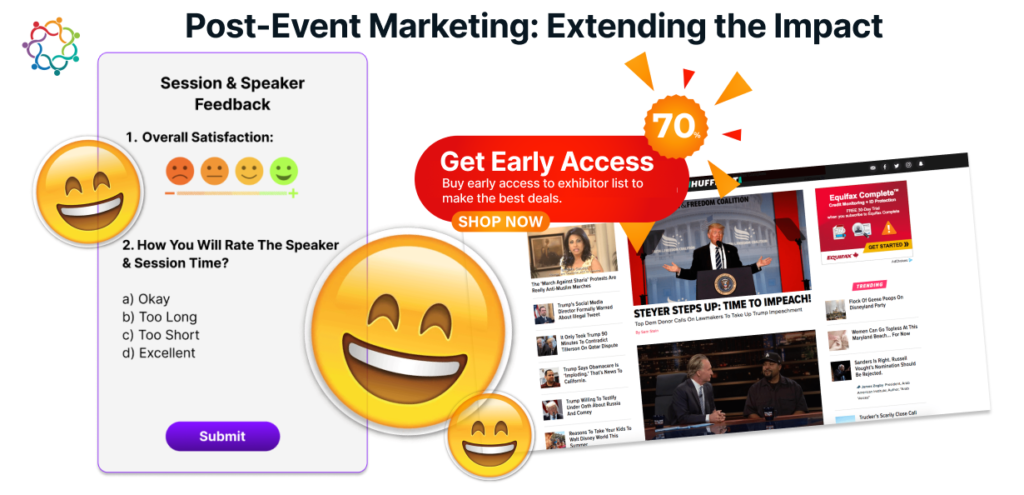
The energy may have subsided, but the connections and value created at your event have lasting power. Post-event marketing is all about extending the impact, fostering relationships, and turning attendees into long-term brand advocates. Here’s how to keep the conversation going:
Utilize surveys or polls (via email or a dedicated landing page) to gather feedback on their experience. Meanwhile, ask about the content, speaker effectiveness, and overall event satisfaction. Understanding what resonated and what could be improved is crucial for planning future iterations.
Create engaging blog posts, social media content, and email newsletters showcasing the event’s best moments. Make sure to include captivating photos, insightful quotes from speakers, and attendee testimonials. This not only reminds the attendees of the value they received but also entices potential attendees for future events.
Follow up with the attendees who expressed interest using personalized emails. Segment your leads based on their interests and tailor the content accordingly. Offer them valuable resources related to the event theme, exclusive discounts, or early access to future events. This demonstrates you value their connection and keeps your brand top-of-mind.
6. Post-Event Marketing: Measuring the Success (1 Month After)

The applause may have died down, but the learning doesn’t stop here. One month after your event, it’s time to delve into the data and measure the success of your marketing efforts. This post-event marketing phase focuses on analyzing metrics, attendee feedback, and ROI to identify areas for improvement and build a roadmap for even more impactful events in the future.
Dive deep into the data collected from website traffic, registration details, and survey responses. Further, analyze key metrics like ROI, attendee demographics, and engagement to gauge event success and identify opportunities for improvement. This data becomes your roadmap for future event optimization.
Send personalized thank-you emails to the attendees for their participation. Maintain communication by sharing relevant industry news, upcoming events, or exclusive content to keep them engaged with your brand and promote long-term relationships.
Your Event Marketing Toolkit
Now that you have a comprehensive checklist to guide your event marketing efforts, let’s explore some valuable tools and resources to streamline your workflow and maximize your impact:
Several platforms like Samaaro simplify event management by offering tools for registration, marketing automation, and attendee tracking. These platforms can save you time and resources, allowing you to focus on event strategy and attendee engagement.
Creating engaging content is crucial for pre-event promotion. Tools like Canva, Adobe Spark, and Lumen5 offer user-friendly interfaces for designing eye-catching graphics, infographics, and even short video snippets to promote your event across various channels.
Platforms like Hootsuite, Buffer, and Sprout Social help you schedule social media posts in advance, track performance metrics, and engage in conversations with your audience across various platforms, saving you valuable time and ensuring consistent brand messaging.
Analytics tools like Google Analytics and social media platform insights provide valuable data on website traffic, social media engagement, and registration conversions. In fact, analyzing this data helps you understand what’s working and where you can improve your marketing strategies for future events.
Conclusion
A successful event is the culmination of meticulous planning, strategic execution, and a well-defined marketing roadmap. By leveraging this comprehensive checklist and employing the tools and resources available, you can create a winning event marketing strategy that drives attendee engagement, achieves your event goals, and leaves a lasting impression.
Your journey to event marketing mastery doesn’t end here! Subscribe to our newsletter for ongoing event marketing tips, industry insights, and downloadable resources to help you craft even more impactful events. Don’t hesitate to share this comprehensive checklist with your network of event planners and marketers; together, we can elevate the event experience for everyone.
Ready to elevate your events? Book a demo and start your free trial today!
In today’s digital age, event apps have become an indispensable tool for enhancing attendee engagement and improving the overall event experience. By providing a centralized platform for accessing information, networking, and participating in activities, event apps can significantly elevate the value and impact of your events.
1. Enhancing Attendee Engagement
In today’s competitive event landscape, creating a memorable and engaging experience for attendees is crucial for driving success. This section will explore key tactics for captivating your audience and creating an unforgettable event experience.
Event apps can utilize attendee data, such as registration information, past event attendance, and session preferences, to deliver highly personalized content and recommendations. This ensures that attendees receive relevant and valuable information tailored to their specific interests. For example, an app could recommend sessions based on an attendee’s job title, industry, or previous event attendance.
Event apps can incorporate interactive elements and gamification to enhance attendee engagement and participation. For example, polls and quizzes can gather feedback and insights on various topics related to the event. On one hand, leaderboards can create a sense of competition and encourage attendees to participate in activities and challenges. On the other, gamified challenges can offer rewards or incentives for completing tasks, motivating attendees to engage with the app and event content.
Event apps can provide features that make it easy for attendees to connect with each other and build relationships. Attendees can create profiles with information about their interests, expertise, and company. This allows them to search for other attendees who share similar interests or are attending specific sessions. Additionally, event apps can provide tools for attendees to initiate conversations, schedule meetings, and join group chats. These features facilitate networking and help attendees make valuable connections.
Event apps can keep attendees informed with real-time updates on event schedules, speaker information, session changes, and other important details. This ensures that attendees have the latest information at their fingertips and can plan their time accordingly. Additionally, event apps can provide features such as push notifications to send alerts to the attendees about important updates or announcements and session reminders to remind them about upcoming sessions or events.
2. Improving Event Logistics

Streamlining event logistics is essential for creating a seamless and enjoyable experience for attendees. By optimizing processes such as registration, check-in, and on-site management, you can reduce stress, improve efficiency, and enhance the overall event atmosphere. This section will explore how event apps can help you improve event logistics and create a more positive experience for attendees.
Event apps can significantly simplify the registration and check-in process for attendees, reducing wait times and improving the overall event experience. By allowing attendees to register online and use digital badges for entry, event organizers can eliminate manual paperwork and streamline the check-in process. This not only saves time for both attendees and staff but also reduces the risk of errors and improves efficiency.
Event apps can provide attendees with easy access to event schedules, agendas, and speaker information. This allows attendees to plan their time effectively, identify sessions they are interested in, and avoid missing important events. Additionally, event apps can offer features such as interactive maps to help attendees navigate the venue and find session locations.
By offering contactless payment options and digital ticketing within the event app, organizers can streamline transactions and reduce lines. This provides a more convenient and efficient experience for attendees, especially in crowded environments. Contactless payments can also help to reduce the risk of fraud and improve security.
3. Enhancing Attendee Experience
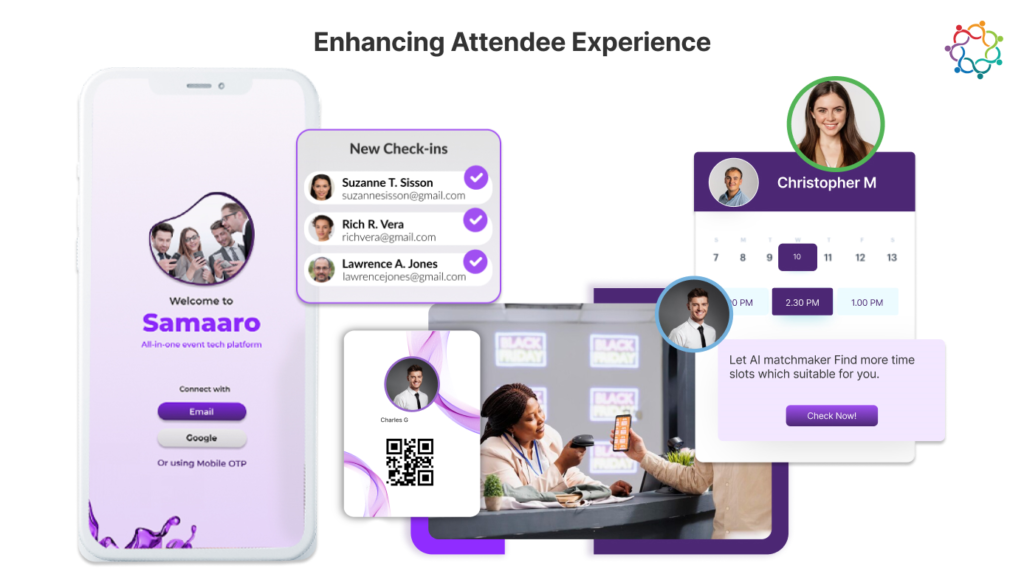
Creating a memorable and positive attendee experience is essential for the success of any event. Event apps can play a vital role in enhancing attendee satisfaction by providing personalized features, streamlining logistics, and offering valuable resources. By focusing on these key areas, you can create an event that exceeds attendee expectations and drives long-term engagement.
· Offering Valuable Content and Resources:
To enhance the attendee experience, event apps should provide access to exclusive content and resources that go beyond the basic event information. This can include speaker slides and presentations, handouts and supplementary materials, recordings of key sessions, and exclusive content such as interviews with speakers or behind-the-scenes footage.
· Creating a Seamless and Intuitive User Experience:
A well-designed event app should be easy for attendees to navigate and use. Pay attention to the following factors: clear and concise navigation, consistent branding, mobile optimization, and accessibility features. A well-designed app will make it easy for attendees to find the information they need, navigate between different sections, and use the app’s features without any difficulties.
· Providing Personalized Support and Assistance:
To demonstrate your commitment to providing excellent customer service and enhance the overall attendee experience, offer in-app support or chat features to assist attendees with any questions or issues they may encounter. Provide immediate assistance through live chat or in-app messaging, and create a comprehensive FAQ section to address common questions and concerns. Additionally, clearly display contact information for support staff or event organizers.
4. Measuring App Effectiveness
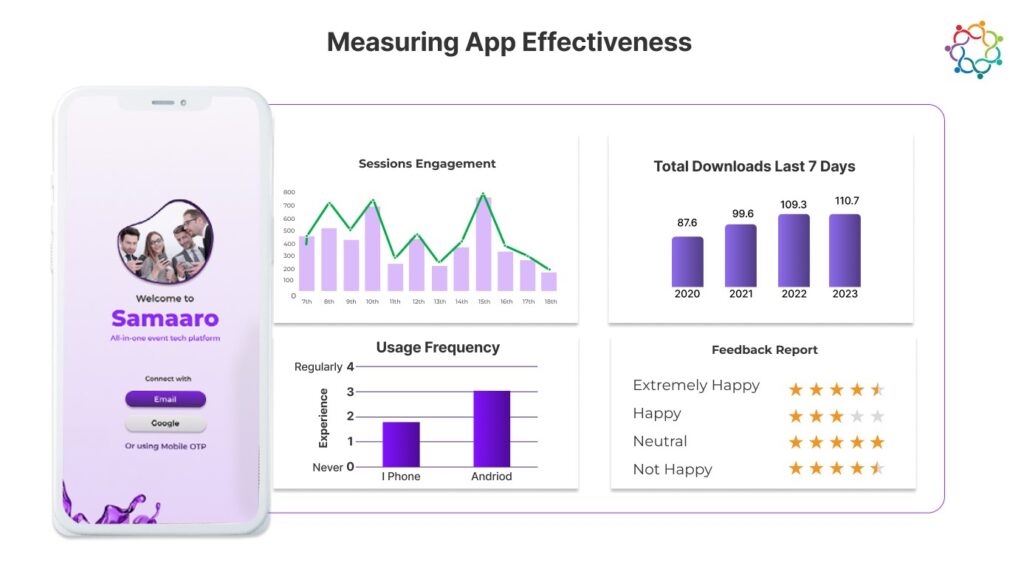
To evaluate the impact of your event app and identify areas for improvement, it’s essential to track key metrics and analyze app usage data. This section will discuss the key metrics to track and provide guidance on analyzing app data to optimize your event app strategy.
To effectively measure the effectiveness of your event app, it’s essential to track key metrics that provide insights into app usage and attendee engagement. These metrics can help you understand how attendees are using the app, identify areas for improvement, and measure the app’s impact on event outcomes. Some important metrics to consider include app downloads, usage frequency, time spent in the app, user feedback, feature usage, session attendance, and networking activity.
By carefully analyzing these key metrics, you can gain valuable insights into your app’s performance and identify areas for improvement. This data can help you tailor content recommendations to better match attendee preferences, enhance the user experience by addressing pain points and streamlining navigation, prioritize feature development based on usage data, and ultimately measure the app’s return on investment (ROI).
Event apps have become an essential tool for enhancing attendee engagement and improving the overall event experience. By providing personalized content, streamlining logistics, and offering valuable features, event apps can help you create memorable and successful events. By following the best practices outlined in this guide, you can leverage event apps to elevate your events and drive attendee satisfaction.
Ready to elevate your events? Book a demo and start your free trial today!
Humans are wired for stories. From ancient cave paintings to modern blockbusters, narratives have the unique ability to tap into our emotions, spark our imaginations, and imprint themselves on our memories. In a world overflowing with content, stories cut through the noise. They make information relatable, spark curiosity, and leave a lasting impression. Event marketing, too, thrives on connection.
Ever attended an event that stayed with you long after the final presentation? Perhaps it wasn’t just the informative content or the impressive venue. Maybe it was the way the event unfolded like a captivating story, weaving together insights, emotions, and a sense of shared purpose. In today’s digital age, bombarded with information overload, stories are the lifeblood of capturing and holding attention. This is where event marketing and storytelling converge, creating a powerful force for forging deeper connections with your target audience.
The Impact of Storytelling
Events provide a platform for interaction, education, and community building. But what truly elevates an event from informative to impactful? Integrating storytelling into your event marketing strategy is the key. By weaving a compelling narrative, you can:
Stories are inherently engaging. They draw audiences in, ignite curiosity, and encourage active participation. People are more likely to remember information presented within a narrative framework.
Stories evoke emotions. By tapping into emotions like excitement, hope, or inspiration, you can create a deeper connection with your audience, generating brand loyalty and trust.
Stories are sticky. Compelling narratives leave a lasting impression, making your event stand out in the crowded event landscape and ensuring the attendees remember your key takeaways long after the event ends.
The Science Behind Storytelling

The power of storytelling in event marketing goes beyond mere entertainment. Neuroscience research reveals that stories trigger specific brain responses, enhancing memory retention and emotional connection. One popular storytelling trick is called the “hero’s journey.” It’s basically a story structure that everyone can understand. It has a clear main character who faces challenges and overcomes them, changing for the better in the process. This kind of story makes people excited about the positive changes your event can bring.
How to Craft a Compelling Story for Your Event
Your event has the potential to be more than just a gathering; it can be a transformative journey. To capture hearts and minds, craft a compelling story that resonates with your audience. Here’s your roadmap:
1. Find Your Core:
Identify the central theme or message you want your event to convey. What problem are you solving? What transformation do you promise?
2. Define Your Characters:
Who are the key players in your event story? The attendees are not just passive observers; they are the heroes of their own event journey. Highlight your speakers as inspiring guides and your organization as a trusted partner in their pursuit of knowledge and growth.
3. Conflict and Transformation:
Every good story has an obstacle to overcome. What challenges will your event address? How will it equip the attendees to overcome these hurdles and achieve their goals?
4. Embrace Authenticity:
The most powerful stories are those that ring true. Don’t fabricate narratives; find the authentic stories within your brand, speakers, and attendees.
5. Build Anticipation:
Tease out your event story through pre-event marketing campaigns. Use social media to share snippets of speaker anecdotes, attendee testimonials, and sneak peeks at the event experience. This will create excitement and a sense of anticipation in your audience.
How to Enhance Your Storytelling

Storytelling isn’t just about sharing information; it’s about creating connections and leaving a lasting impression. Here’s how to elevate your event marketing with the power of narrative:
1. Choose the right storytelling channels:
Where does your target audience spend their time? It is important to tailor your stories to the platform. While on Twitter, keep it concise with visuals and quotes. But on Instagram, showcase the event’s energy with photos and behind-the-scenes glimpses. Meanwhile, use email marketing for personalized narratives highlighting relevant sessions and testimonials for social proof.
2. Practice storytelling:
Successful storytelling takes practice. Start small with social media posts that introduce a problem, your event’s solution, and evoke emotion. Pay attention to captivating stories and find the authentic narratives within your brand, speakers, and attendees. The more you practice, the more comfortable you’ll become in weaving a narrative that resonates with your target audience.
3. Refine your message:
Gather feedback on your storytelling efforts. Ask colleagues, potential attendees, or even past attendees for their impressions. You should know if your stories are clear, engaging, and resonating with your target audience. So, use this feedback to refine your message and ensure your stories are truly captivating.
4. Embrace Measurement:
Track the effectiveness of your storytelling. Analyze the key metrics across different channels, like website traffic, social media engagement, and event registrations, to understand how your stories are impacting your event marketing goals. Find out if your storytelling efforts led to increased brand awareness, higher registration numbers, or more positive attendee feedback. This data will help you refine your storytelling approach and optimize your event marketing campaigns for future events
How to Integrate Storytelling with Marketing Channels
Storytelling is not confined to a single channel. It can be integrated seamlessly across your entire event marketing strategy:
1. Event Descriptions:

Craft a captivating story that breathes life into your event website and promotional materials. Instead of simply listing features, focus on the “whats”:
Paint a picture of the attendee’s journey, from the initial spark of curiosity to the post-event feeling of empowerment. All the while, use evocative language and powerful verbs to create a sense of excitement and anticipation.
2. Social Media Storytelling:
Social media platforms like Twitter and Instagram are perfect for sharing bite-sized stories with captivating visuals. Here are some ways to take full advantage of them:
3. Email Marketing with Flair:
Move beyond generic announcements and craft captivating email sequences that tell the story of your event. Here are some tips:
4. Press Releases and Media Outreach

Use captivating narratives to garner media attention and secure valuable coverage. In fact, tell the story about your event and the impact it aims to create.
Make sure to use engaging language, highlight the unique elements of your event, and offer interview opportunities with key speakers.
5. Storytelling at the Event:
Don’t let the story end with the pre-event hype. Integrate storytelling elements into the event itself:
How to Engage the Audience with Visual Storytelling
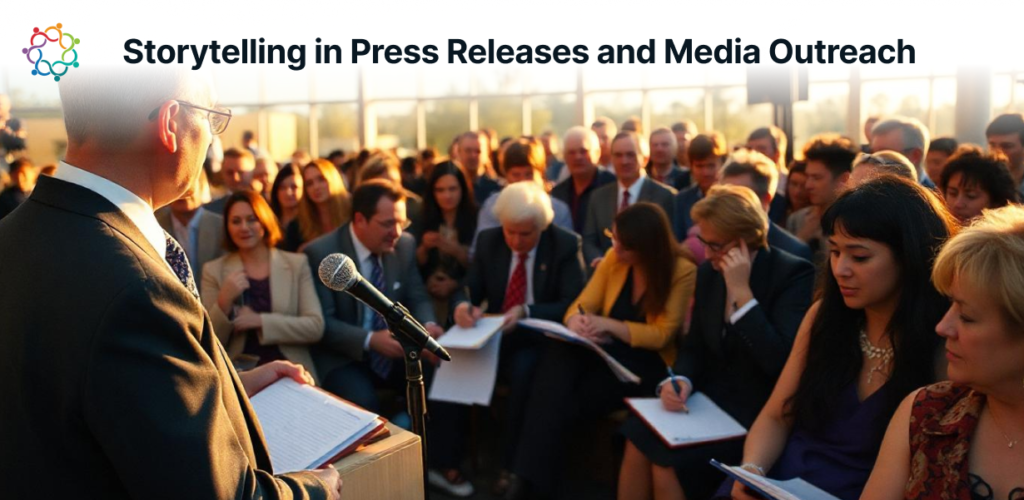
While words paint a powerful picture, visuals can truly elevate your event storytelling. Here are some ways to incorporate visual storytelling for impactful event marketing:
Invest in professional photography and videography that captures the essence of your event. Show, don’t tell. Because images and videos can showcase the energy of past events, highlight engaging speakers, and give the potential attendees a sneak peek at the experience that awaits them.
Transform complex information into engaging and easily digestible infographics or data visualizations. This is a fantastic way to present key takeaways from past events or showcase the impact your events aim to create.
Attention spans are short on social media platforms. Therefore, it’s a great idea to use eye-catching graphics, memes, and GIFs and tell your event story in short, visually captivating bursts.
Create a live social media wall at your event where the attendees’ photos and tweets are displayed in real-time. This not only creates a sense of community but also allows you to visually capture the energy and excitement of the ongoing event.
Explore interactive storytelling tools like quizzes, polls, and augmented reality experiences to engage your audience on a deeper level. As a result, it will allow the attendees to actively participate in your event story and create lasting memories.
The Ripple Effect: Storytelling Beyond the Event

The power of storytelling in event marketing extends far beyond the event itself. Here’s how to leverage event narratives to create a lasting impact:
Don’t let the story end with the closing keynote. Share event highlights, speaker insights, and attendee testimonials through blog posts, social media content, and email campaigns. This keeps your audience engaged, maintains brand awareness, and positions you as a thought leader in your industry.
Use your event experiences to build lasting relationships with the attendees. Personalized email sequences that reference their participation and offer valuable post-event resources demonstrate your commitment to their growth. That’s why it is crucial to make the most of the event’s networking opportunities and create connections that extend beyond the event itself.
Events provide a platform for creating a community around your brand. Encourage the attendees to share their event stories on social media, host online forums for ongoing discussions, and organize follow-up events to keep the conversation flowing.
Conclusion
By embracing storytelling, you can transform your event marketing from merely informative to truly impactful. It allows you to connect with your audience on a deeper level, forge emotional connections, and create a lasting impression. So, weave your narrative, craft your message, and captivate your audience with the magic of storytelling.
Ready to elevate your events? Book a demo and start your free trial today!

Built for modern marketing teams, Samaaro’s AI-powered event-tech platform helps you run events more efficiently, reduce manual work, engage attendees, capture qualified leads and gain real-time visibility into your events’ performance.


© 2025 — Samaaro. All Rights Reserved.